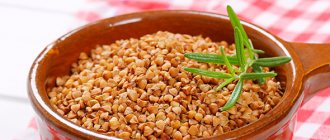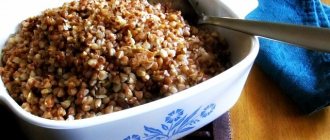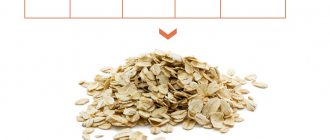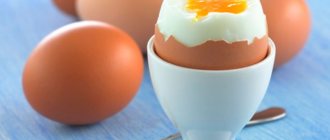What cereal is most popular among those losing weight? Of course, buckwheat. The expression “sitting on buckwheat with breasts” is known to many who have at least once tried to lose excess weight with the help of strict diets or absolutely pure proper nutrition. You can make many delicious dishes from this cereal, but the simplest and healthiest for the body, and also familiar from childhood, is buckwheat porridge. If you are determined to fight those extra pounds, you should understand the issue of calorie content of the dish and, of course, determine how often and in what form you can eat it.
Chemical composition and calorie content of buckwheat with milk (per 100 grams)
Porridge in this form is nutritious, tasty and low in calories.
| buckwheat with milk calories | ||||
| substances | buckwheat (per 100 g dry) | milk (100 g = half a glass) | 100 g boiled in water (20 g dry cereal + 80 g milk) | % of daily value |
| calorie content | 343 | 252 kJ (60 kcal) | 116 | |
| carbohydrates | 71,5 | 5.26 | 21,8 | |
| fats | 3,4 | 3.25 | 2,5 | |
| squirrels | 13,25 | 3.22 | 4,4 | |
| vitamins (mg) | ||||
| retinol (A) | 46 mcg | 35,8 | 4 | |
| thiamine (B1) | 0,101 | 0,044 | 0,04 | 4 |
| Riboflavin (B2) | 0,425 | 0,183 | 0,15 | 12 |
| Cyanocobalamin (B12) | — | 0.45 mcg | 0,35 | 15 |
| Kholin | — | 14,3 | 11,2 | 1,5 |
| Vitamin D | — | 2 | 1,6 | |
| Niacin (B3) | 7,02 | — | 1,4 | 7 |
| Pantothenic acid (B5) | 1,233 | — | 0,24 | 5 |
| Vitamin B6 | 0,21 | — | 0,04 | 3 |
| Folic acid (B9) | 30 | 6 | ||
| phytic acid | 1000 | 200 | ||
| Minerals | ||||
| calcium | 18 | 113 | 94,6 | 9 |
| magnesium | 231 | 10 | 52 | 15 |
| potassium | 460 | 132 | 204 | 5 |
| sodium | 1 | 43 | 35 | 2 |
| iron | 2,2 | — | 0,4 | |
| manganese | 1,3 | — | 0, 2 | |
| phosphorus | 347 | — | 68 | 10 |
| zinc | 2,4 | — | 0,48 | 5 |
The table shows that buckwheat with milk has a low calorie content. Only 116 calories per 100 g. It contains many minerals. But once they enter the body, they begin to fight to be absorbed. Magnesium interferes with the absorption of calcium. And that one - to the iron. The body always gives preference to scarce substances. Much also depends on the microflora and individual characteristics of the digestive system. Therefore, the substances described in the table are not completely absorbed.
Porridge on the water
How many calories are in buckwheat boiled in water? If we are talking about traditional preparation, then 3 times less than raw. Take the cereal, rinse it, add water to it in the proportion of 2 parts water to 1 part cereal, and put it on high heat. Bring to a boil, reduce heat to low, cover and cook for 10-12 minutes until all the water is absorbed. After this, turn off the heat and leave for another 15 minutes so that the boiled buckwheat infuses. You can cover the pan with towels or place it in a warm oven. The calorie content of boiled buckwheat using this method will be approximately 110 kcal.
The calorie content of buckwheat porridge can be reduced a little more (by 5-10 kcal) if you do not cook it, but steam it with boiling water. In this case, the buckwheat is washed and then placed in a thermos. You can get by with regular dishes, but you will need to wrap them so that the heat lasts longer. Now you need to measure out 2 times more water than buckwheat, boil it and pour it into the cereal. After 2 hours of steaming, the porridge can already be eaten. Or you can leave it overnight, then in the morning you will have ready-made buckwheat porridge, which has the lowest calorie content possible.
The only thing to keep in mind is that steamed buckwheat will be less tasty compared to boiled buckwheat. But it will retain all its nutritional properties.
Properties of buckwheat with milk
This dish consists of products with beneficial properties. The positive impact of each is beyond doubt. Buckwheat and milk together:
- better saturate the body with necessary substances;
- these products complement each other and contain a wider range of vitamins and minerals;
- low in calories, since adding milk allows you to reduce the amount of buckwheat you eat;
- more nutritious. The gastrointestinal tract takes longer to digest foods like soups;
- makes the diet more varied. You can eat it sweet by adding sugar. Or neutral (no spices).
Why is it useful?
Useful for its significant content of phosphorus, magnesium and calcium. These microelements are needed to keep bones and teeth strong. The dish is also low in fat. Therefore, it can be eaten by people trying to lower their cholesterol levels.
Harm and contraindications
Buckwheat contains phytic acid. The plant needs it to accumulate phosphorus. But the human body does not break it down well. In addition, this acid attracts other minerals. For example, iron and calcium. The intestines cannot digest phytate with trace elements attached to it. Removes them completely from the body.
Important! It is neutralized by alkaline solutions. And the sediment that it forms with minerals is destroyed by sodium citrate (found in lemon juice). Soaking in a solution with sodium is ideal for legumes, but this procedure is not suitable for processing buckwheat.
Find information that milk eliminates the harm of phytic acid. But there is no scientific evidence for it.
Studies have shown that with regular consumption of products with phytic acid, the microflora adapts to process it. Bacteria appear inside the intestines that are able to break the bonds between phytic acid molecules and minerals. Therefore, you need to eat porridge every day.
How to properly cook buckwheat with milk
The dish will please both meat-eaters and vegetarians. To cook it deliciously, you need:
- Sort out the buckwheat.
- Fill the pan with water (pour 1.5 times more than the cereal).
- Boil.
- Add grains.
- Reduce heat.
- Keep on low heat until the water disappears.
- Add milk. The proportion with buckwheat is equal (or more, depending on taste preferences).
- Lactose milk already contains sugar. But you can add more to enhance the taste.
- Cook buckwheat in milk for 10 minutes.
- Once ready, add honey, cinnamon, jam, and fruit to taste.
Buckwheat porridge and diet
Is it worth trying to lose weight on such a dish? Of course, the answer will be yes. However, you should understand that not all buckwheat porridge is good for your figure. Add condensed milk, sugar, butter, and the product will turn into a source of simple carbohydrates. If possible, it is better to leave buckwheat only with salt or a very small piece of butter added to the finished dish. Also, nutritionists recommend cooking porridge with lactose-free skim milk or with classic milk, but diluted in half with water.
Considering that there are not many calories in a serving of buckwheat porridge (if there are only 200-300 g in a plate, that’s about 240 kcal), you can safely eat it for breakfast and lunch. But experts do not recommend it for dinner, since it is better to give preference to light proteins - carbohydrates take a long time to digest and in the evening they can begin to turn into deposits.
Also, to ensure that buckwheat porridge only benefits your figure, try to combine it with salads, herbs, boiled eggs or omelettes, chicken or turkey. Combinations with red meat (pork, beef) and fish are more difficult to digest. However, if you do strength training after eating, this is a good way to get both a large supply of energy and a source for building new muscle fibers. But on days without physical activity, it is better not to create such combinations in your plate.
Features of use
Buckwheat was cultivated in India and Nepal more than 5,000 years ago. From there it came to Japan, China, and the Caucasus. Then she moved to Europe. And, despite the fact that it is considered an original Russian dish, it was only brought to the Slavs from Byzantium in the 7th century.
This cereal can be cooked without milk. Prepare porridge in water. Before eating, heat it up and add milk. This method of consumption will increase the shelf life of the dish by 2-3 times.
There is whole and ground buckwheat. The crushed one does not need to be cooked. Pour hot milk and let stand for 5-7 minutes. Eating chopped buckwheat with milk for breakfast is convenient and satisfying.
When losing weight
This dish is ideal for weight loss. Since it is light, quick to prepare and contains a lot of useful substances.
Buckwheat is a staple product in many diets. Adding milk instead of butter or sauce makes the meal healthier and lower in calories. The dish contains only 232 calories per large serving. But there are a lot of nutrients. Microelements contained in milk are needed by those losing weight to maintain the condition of their skin, hair, and nails.
During pregnancy and pregnancy
Calcium is vital for mother and fetus during pregnancy. Milk is an excellent source of this mineral. This liquid is not always efficiently processed by the body. Scientists have found that pregnant women have an increased ability to extract calcium from milk. This fact makes buckwheat with milk especially useful for expectant mothers and nursing mothers.
It is important to know! There is an opinion that milk is poorly absorbed by adults. Because their body does not produce enough of an enzyme called lactase. Research has shown that the human body has adapted in the process of evolution. 80% of people with a European phenotype can consume milk and receive many benefits. Most residents of African countries, on the contrary, were unable to properly digest dairy products.
For diabetes
Milk contains 5.26 g of sugar (lactose - broken down during digestion into galactose and glucose). It has a low glycemic index (30). But its use with other products increases this figure by 30-40%. Therefore, diabetics are not recommended to consume buckwheat with milk.
For pancreatitis, gastritis
Milk is low in fat. It does not overload the pancreas. Therefore, if you have pancreatitis, you can eat the dish. But it is better to add low fat or 1%.
With gastritis, milk envelops the walls of the gastrointestinal tract. Prevents discomfort and pain. Buckwheat should be boiled until soft.
For constipation
Problems with stool can occur when:
- nervous overstrain;
- lack of moisture in food;
- lack of fiber;
- bad microflora.
Milk saturates the body with water. It also contains lactic acid bacteria. They are involved in the digestion of food. Buckwheat contains a lot of dietary fiber. They exfoliate the intestinal walls. Improves his motor function. Thus, buckwheat with milk helps with constipation.
Buckwheat porridge: features
The main advantage of this cereal is its high level of plant proteins, which help the body stay full for a long time. In addition, it is proteins that protect against sudden spikes in sugar while eating a dish. But in addition to protein, buckwheat contains another important element - slow (complex) carbohydrates, which take a very long time to digest, which also prevents you from getting hungry quickly after eating. True, there is a flip side to the coin, which is felt by people with a sensitive gastrointestinal tract: buckwheat is a rather heavy cereal and the first hour and a half after eating it there may be an unpleasant feeling of fullness.
The calorie content of 100 g of dry buckwheat is 313 kcal. There are also 12.6 g of protein, 62.1 g of carbohydrates and only 3.3 g of fat. It is noteworthy that these are indicators for the core - whole grain. Prodel (chopped) contains fewer calories - 309 kcal, but more carbohydrates (65 g) and less protein (9 g).
How many calories are in buckwheat porridge is influenced by many factors. First of all, this is a cooking recipe, where it is important to take into account the ratio of liquid and cereal (the more water the grain absorbs, the fewer calories there will be in the plate), the specific type of liquid (milk, water, broth) and additional components. Unlike rice porridge, buckwheat is traditionally boiled in water, so it has a relatively low calorie content. A viscous porridge of cereal and water in a 1:2 combination will have only 90 kcal per 100 g serving. And if you increase the ratio to 1:4 and boil well over low heat, you will get only 59.6 kcal. But keep in mind that we are talking about a dish without oil and other additives.
As for how many calories are in buckwheat porridge with milk, it is worth clarifying what percentage of fat it has. If you take 3.2% and make the ratio between cereal and liquid 1:5 (by weight - not volume!), and also add 5 g of butter to the pan after cooking the dish, you will get only 112 kcal in a 100 g serving. If you dilute milk in half with water, you will get 85 kcal. And if you get rid of the oil, you will already have 79 kcal.
Use in folk medicine
Traditional medicine gives preference to natural medicines. He considers chemically synthesized drugs to be insufficiently effective due to the abundance of side effects. One of its tenets is that you need to eat food as medicine, otherwise you will have to take medicine as food. Therefore, she recommends eating buckwheat with milk for prevention and treatment:
- gastritis;
- arthritis and arthrosis;
- osteoporosis;
- frequent colds, decreased immunity;
- muscle injuries;
- obesity;
- elevated cholesterol levels.
Buckwheat with milk is a versatile, tasty dish. But the digestibility of the substances in it is questionable. Because minerals interfere with the absorption of each other. In addition, enzymes of different groups are needed to digest these products. If there are problems with digestion, then the intestines may not quickly cope with processing the incoming food.
Then fermentation processes and bloating will begin. But a healthy digestive system does not have such problems. Therefore, you need to decide whether or not to eat this dish yourself, focusing on your feelings and well-being.
When to count calories
The energy value of boiled buckwheat is a relevant issue for those who are trying to eat in accordance with the standards established by nutritionists. How many calories you can absorb per day is not an easy question. If a person is already elderly, fewer calories are needed, if there is heavy physical activity, more. But on average it is required per day:
- men - 2800 kcal;
- women - 2400 kcal.
Everything that is not burned is stored as fat. And if a person has neglected these rules for a long time, has accumulated a lot of excess in the body and is now trying to get rid of it, it is better to eat more modestly. In this case, you should calm down your taste buds and switch to steamed buckwheat without salt for a while. It will provide the body with proteins and carbohydrates, as well as many essential microelements, and at the same time will allow you to lose weight.
However, if you have not driven yourself to such an extreme, perhaps you should not so carefully calculate how many calories are in buckwheat porridge. It’s better to just enjoy a delicious dish from time to time, enriching it with a variety of additives.
Buckwheat goes well not only with butter and sugar, but also with cottage cheese, mushrooms, vegetables, and various types of meat. Sometimes everyone can afford to think not about the calorie content of buckwheat porridge, but about its incomparable taste.











